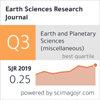厚松散层下开采沉陷预测模型的建立及其参数反演方法研究
IF 0.5
4区 地球科学
Q4 GEOSCIENCES, MULTIDISCIPLINARY
引用次数: 0
摘要
中国的煤矿大多在地下开采,这必然会造成地表变形,引发一系列地质灾害。因此,寻找一种合适的方法来预测地下开采引起的地面下沉是至关重要的。中国最常用的预测模型是概率积分模型(PIM)。但当该模型应用于厚松散层下开采的地质条件时,沉降盆地边缘的预测收敛速度要快于实测沉降情况。为了解决这一问题,本文建立了一种模型形状与PIM相似但边界值更大的几何模型。然后提出了一种改进的布谷鸟搜索算法(ICSA)来计算GM参数。通过模拟工作面,验证了ICSA的稳定性和可靠性。最后,将ICSA与GM、PIM相结合,对淮南矿区厚松散层地质开采条件下的6个工作面进行拟合。结果表明,将GM应用于厚松散层的地质开采条件下,可以很好地解决上述PIM问题。通过对比分析得出,除主要影响半径外,GM和PIM参数均可取相同值。本文章由计算机程序翻译,如有差异,请以英文原文为准。
Research on the establishment of a mining subsidence prediction model under thick loose layer and its parameter inversion method
Most of the coal mining in China is underground, which will inevitably cause surface deformation and trigger a series of geological disasters. Therefore, it is essential to find a suitable method to forecast the ground sinking caused by underground mining. The most commonly used prediction model in China is the probability integral model (PIM). But when this model is used in the geological condition of mining under thick loose layers, the predicted edge of the sinking basin will converge faster than the actual measured sinking situation. A geometric model (GM) with a similar model shape as the PIM but with a larger boundary value was established in this paper to solve this problem. Then an improved cuckoo search algorithm (ICSA) was proposed in this paper to calculate the GM parameters. The stability and reliability of the ICSA were verified through a simulated working face. At last, the ICSA, in combination with the GM and the PIM, was used to fit 6 working faces with the geological mining condition of thick loose layers in the Huainan mining area. The results prove that GM can solve the above-mentioned PIM problem when it is used in geological mining conditions of thick loose layers. And it was obtained through comparative analysis that the GM and the PIM parameters can take the same value except for the main influence radius.
求助全文
通过发布文献求助,成功后即可免费获取论文全文。
去求助
来源期刊

Earth Sciences Research Journal
地学-地球科学综合
CiteScore
1.50
自引率
0.00%
发文量
0
审稿时长
>12 weeks
期刊介绍:
ESRJ publishes the results from technical and scientific research on various disciplines of Earth Sciences and its interactions with several engineering applications.
Works will only be considered if not previously published anywhere else. Manuscripts must contain information derived from scientific research projects or technical developments. The ideas expressed by publishing in ESRJ are the sole responsibility of the authors.
We gladly consider manuscripts in the following subject areas:
-Geophysics: Seismology, Seismic Prospecting, Gravimetric, Magnetic and Electrical methods.
-Geology: Volcanology, Tectonics, Neotectonics, Geomorphology, Geochemistry, Geothermal Energy, ---Glaciology, Ore Geology, Environmental Geology, Geological Hazards.
-Geodesy: Geodynamics, GPS measurements applied to geological and geophysical problems.
-Basic Sciences and Computer Science applied to Geology and Geophysics.
-Meteorology and Atmospheric Sciences.
-Oceanography.
-Planetary Sciences.
-Engineering: Earthquake Engineering and Seismology Engineering, Geological Engineering, Geotechnics.
 求助内容:
求助内容: 应助结果提醒方式:
应助结果提醒方式:


